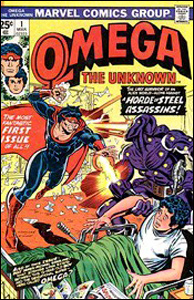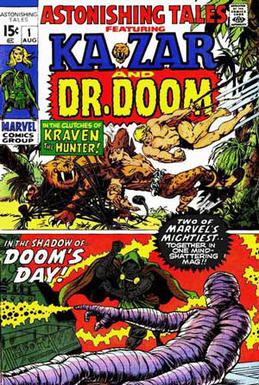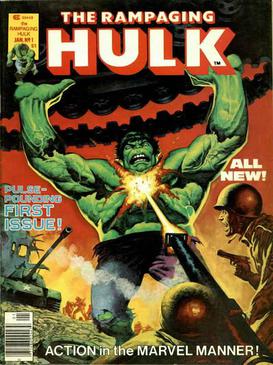
James Shooter is an American writer, editor and publisher for various comic books. He started professionally in the medium at the age of 14, and is known for his successful and controversial run as Marvel Comics' ninth editor-in-chief, and his work as editor in chief of Valiant Comics.
Shogun Warriors was a line of toys released by Mattel Inc. in North America from 1979 to 1980. The line consisted of several imported toys based on Japanese anime mecha.

Drax the Destroyer is a character appearing in American comic books published by Marvel Comics. Created by Jim Starlin, the character first appeared in The Invincible Iron Man #55.
Douglas Moench is an American comic book writer notable for his Batman work and as the creator of Moon Knight, Deathlok, Black Mask, Harvey Bullock, Electric Warrior, and Six from Sirius. He is also known for his critically acclaimed eight-year run on Master of Kung Fu.
An original English-language manga, also known as Amerimanga or OEL manga is a comic book or graphic novel drawn in the style of manga and originally published in English. The term "international manga", as used by the Japanese Ministry of Foreign Affairs, encompasses all foreign comics which draw inspiration from the "form of presentation and expression" found in Japanese manga. This may also apply to manga-inspired comics made in other languages.

Herbert William Trimpe was an American comics artist and occasional writer, best known as the seminal 1970s artist on The Incredible Hulk and as the first artist to draw for publication the character Wolverine, who later became a breakout star of the X-Men.
James H. Williams III, usually credited as J. H. Williams III, is an American comics artist and penciller. He is known for his work on titles such as Chase, Promethea, Desolation Jones,Batwoman, and The Sandman: Overture.
Jumbo Machinder is the name of a series of large-scale plastic robots sold by Bandai's character toy subsidiary, Popy in the 1970s. Although a trademarked brand name, in common usage Jumbo Machinder is often applied to any large-size robot toy roto molded out of polyethylene terephthalate (PET), a sturdy plastic also used for shampoo bottles. Jumbo Machinders are generally 24" in height. After Popy's success with the Jumbo Machinder series, several other Japanese companies, including Takatoku, Nakajima, and Clover began producing large-size plastic robot toys as well. Several of the Jumbo Machinders were retooled for sale in the USA and Europe in the late 1970s as Shogun Warriors.
Phantom Eagle is the name used by two fictional aviator heroes appearing in American comic books.

Omega the Unknown is an American comic book published by Marvel Comics from 1976 to 1977, featuring the eponymous fictional character. The series, written by Steve Gerber and Mary Skrenes and illustrated by Jim Mooney, ran for 10 issues before cancellation for low sales. Despite its short run, it has endured as a cult classic due to its intriguing characters and unusual storytelling. A 10-issue series revamping the character was published from 2007 to 2008, written by novelist Jonathan Lethem and illustrated by Farel Dalrymple.

Planetary Robot Danguard Ace is a Japanese science fiction anime series created by Leiji Matsumoto with Dan Kobayashi.

Red Ronin is a fictional gigantic humanoid robotic construct (mecha) appearing in American comic books published by Marvel Comics, and went on to be a menace to other Marvel characters such as the Avengers and Wolverine.

Weirdworld was a fantasy series created by Doug Moench and Mike Ploog for American company Marvel Comics, set in a dimension of magic. A comic book series titled Weirdworld debuted in 2015 as a tie-in to the Secret Wars storyline, followed by a six-issue series as a part of the All-New, All-Different Marvel branding.

Tower of Shadows is a horror/fantasy anthology comic book published by the American company Marvel Comics under this and a subsequent name from 1969 to 1975. It featured work by writer-artists Neal Adams, Jim Steranko, Johnny Craig, and Wally Wood, writer-editor Stan Lee, and artists John Buscema, Gene Colan, Tom Sutton, Barry Windsor-Smith, and Bernie Wrightson.

Astonishing Tales is an American anthology comic book series originally published by Marvel Comics from 1970 to 1976. Its sister publication was Amazing Adventures.
Black Spectre has two meanings for fictional characters appearing in American comic books published by Marvel Comics. The first Black Spectre is the name of a fictional organization which first appeared in Daredevil #108 and was created by writer Steve Gerber and penciller Bob Brown. It was a league of costumed female commandos, entranced by the Mandrill into doing his bidding, and led by Nekra. The second Black Spectre is a fictional supervillain who first appeared in Moon Knight #25 and was created by writer Doug Moench and penciller Bill Sienkiewicz. The character is one of the greatest enemies of the vigilante Moon Knight.
Maur-Konn is a fictional character appearing in American comic books published by Marvel Comics.

Super-Villain Team-Up is the name of two American comic book series published by Marvel Comics. Both series featured supervillains as the protagonists.

The Rampaging Hulk is a comic book series published by Marvel Comics. The first volume was a black and white magazine published by Curtis Magazines from 1977–1978. With issue #10, it changed its format to color and its title to The Hulk!, and ran another 17 issues before it was canceled in 1981. It was a rare attempt by Marvel to mix their superhero characters with the "mature readers" black-and-white magazine format.

Godzilla, King of the Monsters is an American comic book series published by Marvel Comics. Running for 24 issues from 1977 to 1979, the series starred Godzilla, a Japanese monster film character licensed from Toho. The series is set in the publishers' shared Marvel Universe and was the first ongoing American comic book based on Godzilla.










